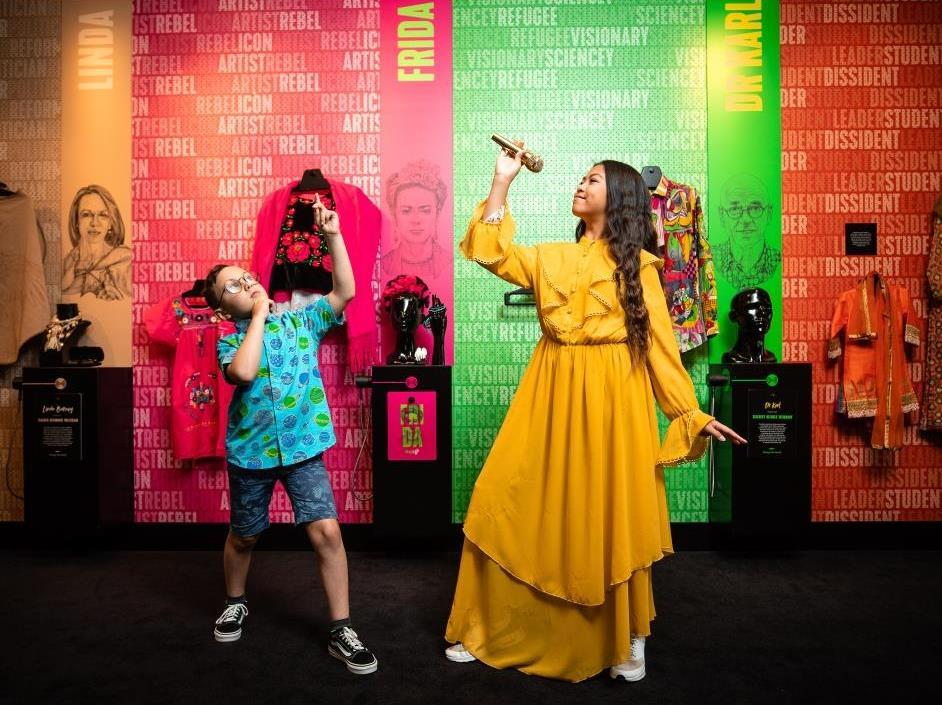Dr Karl or Beyonce? Both are possible at DressUP at MOAD. Image supplied.
For Amy Matthews, Program Coordinator of Education, Youth and Families at Riverside, a performing arts centre in Parramatta, a successful cultural experience for children is one which doesn’t dumb down an experience.
‘If you’re creating work for young people, make it sophisticated and don’t be afraid to go into subjects that are challenging – that are age-appropriate of course, ’ she said. ‘But don’t be afraid to put that sophistication in, because that’s what will reach them.
‘Children like to have a bit more substance in what they watch. You can really see the engagement as opposed to a piece that’s purely superficial and just for entertainment.’
Consulting with the community
Curating Riverside’s program of professional productions for schools, as well as festivals that include Spot on Children’s Festival, Matthews said achieving a program that responds to children’s interest levels and varying age groups can be challenging. This is where consultation comes in.
‘We have a panel of NSW teachers who advise us on what schools need and what would help to complement their arts learning in schools,’ she said.
Riverside also consults with young people to ensure their programs are relevant. Upstage Club is a group that offers successful applicants access to a number of performances, in conjunction with some exclusive workshops led by professional theatre makers, throughout the year. They’re consulted as a panel and give advice on how to reach other young people of a similar demographic.
These consultations are also important when thinking about the design of a space.
Nanette Louchart-Fletcher designs large-scale event-based experiences, exhibitions and programs at the Museum of Australian Democracy (MOAD). She said the way we design physical spaces for kids is just as important as the educational messages the experience can teach them, particularly so when designing for varied age groups.
‘It can be quite challenging to think about co-existence in a learning environment but it is profoundly doable,’ Louchart-Fletcher said. ‘Even with the small spaces, you think about the way in which you can change energy in the way you move through a space. You can use 3D design elements and lightning in a way that can really change the dynamics to naturally attract different kinds of audiences.’

Riverside Theatre’s 2017 Spot on Children’s Festival. Image, Katrina James
You might wonder how an institution such as MOAD can successfully run events for kids which are able to both entertain and educate, given the content the museum presents, but an example of this lies in one of its most popular exhibitions DressUP: Change the world.
This experience allows children to try on the costumes of iconic figures such as Beyonce, Dr Karl, Malala Yousafzai and Adam Goodes. Louchart-Fletcher said the exhibition allows children empathetic engagement through trying on costumes and engaging with a person’s life, such as Dr Karl’s migrant background. It’s all in the way the experience is presented to children.
‘It is possible to have a playful approach to non-school based learning. Free choice learning is what we’re talking about,’ she said.
Matthews said it’s important to get the balance right between education and entertainment through considering a range of variables.
‘Content has to be relevant, important and something that young people need to hear about. It’s getting that value in all those different areas, which can be difficult’ she said.
‘Parents will easily go and book tickets to the Wiggles but when it’s a professional production of a new story and they haven’t heard of the work or characters before, they don’t know what to expect, so building that trust is important.’
And if audiences don’t like something, you’ll know about it quickly, said Louchart-Fletcher.
‘What we often forget with young people is that they are human in the way the rest of us are and we don’t need to talk down to children in the way we design a space, it’s incredibly important. If people don’t like something, they’ll vote with their feet and leave.’





